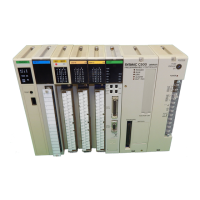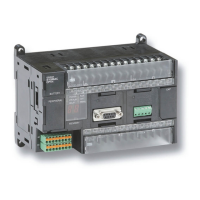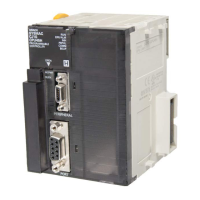Glossary
132
GPC An acronym for Graphic Programming Console.
Graphic Programming Console A programming device with advanced programming and debugging capabilities
to facilitate PC operation. A Graphic Programming Console is provided with a
large display onto which ladder-diagram programs can be written directly in lad-
der-diagram symbols for input into the PC without conversion to mnemonic
form.
header code A code in an instruction that specifies what the instruction is to do.
hexadecimal A number system where all numbers are expressed to the base 16. In a PC all
data is ultimately stored in binary form, however, displays and inputs on Pro-
gramming Devices are often expressed in hexadecimal to simplify operation.
Each group of four binary bits is numerically equivalent to one hexadecimal digit.
host computer A computer that is used to transfer data to or receive data from a PC in a Host
Link System. The host computer is used for data management and overall sys-
tem control. Host computers are generally small personal or business comput-
ers.
host interface An interface that allows communications with a host computer.
Host Link System A system with one or more host computers connected to one or more PCs via
Host Link Units or host interfaces so that the host computer can be used to trans-
fer data to and from the PC(s). Host Link Systems enable centralized manage-
ment and control of PC Systems.
Host Link Unit An interface used to connect a C-series PC to a host computer in a Host Link
System.
I/O allocation The process by which the PC assigns certain bits in memory for various func-
tions. This includes pairing I/O bits to I/O points on Units.
I/O Block Either an Input Block or an Output Block. I/O Blocks provide mounting positions
for replaceable relays.
I/O Control Unit A Unit mounted to the CPU Rack to monitor and control I/O points on Expansion
CPU Racks or Expansion I/O Racks.
I/O delay The delay in time from when a signal is sent to an output to when the status of the
output is actually in effect or the delay in time from when the status of an input
changes until the signal indicating the change in the status is received.
I/O device A device connected to the I/O terminals on I/O Units, Special I/O Units, etc. I/O
devices may be either part of the Control System, if they function to help control
other devices, or they may be part of the controlled system.
I/O Interface Unit A Unit mounted to an Expansion CPU Rack or Expansion I/O Rack to interface
the Rack to the CPU Rack.
I/O point The place at which an input signal enters the PC System, or at which an output
signal leaves the PC System. In physical terms, I/O points correspond to termi-
nals or connector pins on a Unit; in terms of programming, I/O points correspond
to I/O bits in the IR area.
I/O refreshing The process of updating output status sent to external devices so that it agrees
with the status of output bits held in memory and of updating input bits in memory
so that they agree with the status of inputs from external devices.
